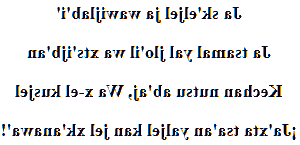Tojolabal love poem
Ja ijlab'ali'
Ja sk'eljel ja wawijlab'i'
Ja tsamal yal jlo'il wa xts'ijb'an
Kechan nutsu ab'aj, Wa x-el kusjel
¡Ja'xta tsa'an yaljel kan jel xk'anawa'!
Thanks to Armando Lopez Arcos


→ French poem ←
Tojolabal language
The tojolabal (chañabal, tojol-ab’al, comiteco), is one of the many Mayan languages. Its speakers, around 50,000 people, are the Tojolabals. They live in Mexico, in the south of the state of Chiapas, and their language is close to Chuj spoken in Guatemala. The word tojolabal means "true language".
The Tojolabal
The Tojolabals (Tojol-ab'ales) are Native Americans from southern Mexico, very close to the border with Guatemala. It was the Spanish chronicler Francisco Ximenez who first mentioned them in the 18th century.
The creation myth for the Tojoabals is this: Volcanic eruptions, forced beings into caves. A flood followed! Later these beings (animal-like) began to have hands, and a man, only one, was initially created. He cried so much in front of his loneliness that he split in two, thus differentiating man and woman.
In their cosmogony, the universe is made up of three parts: the sky, the earth and the sea, and all that is underground. Each of these three worlds is populated by different beings which can break the harmony of the universe at each moment, and for each people, it is above all the heart, but also the brain that tries to maintain a balance.
Today, they are most often farmers (corn, coffee, squash, beans and sugar cane), and artisans (pottery and weaving).
jakaltek